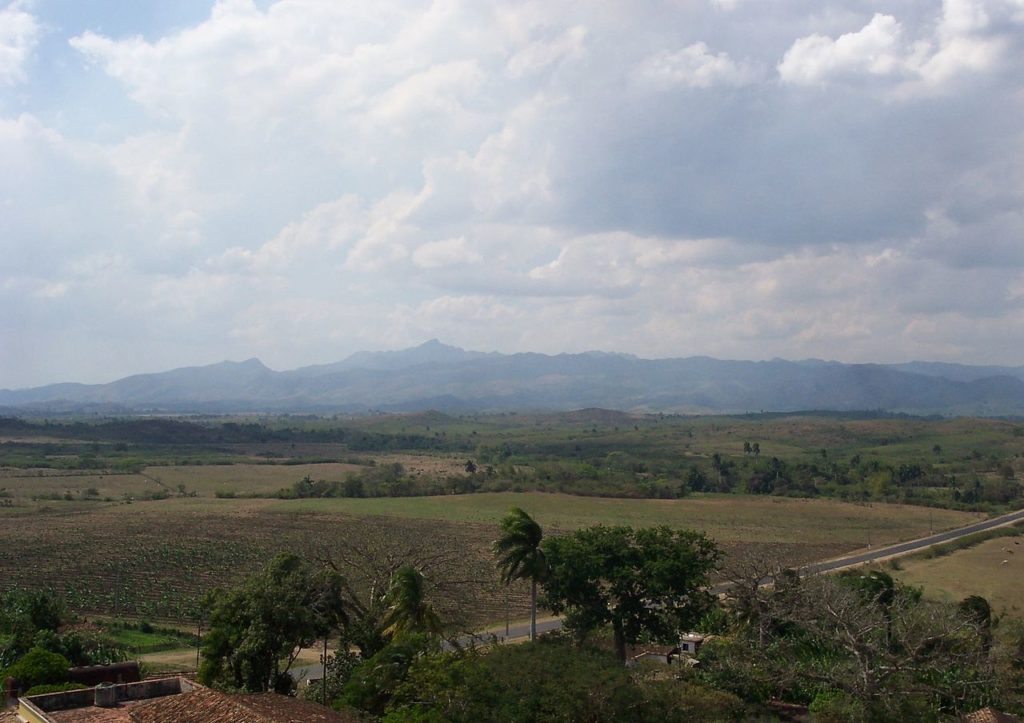In the Valle de los Ingenios neighbouring the city of Trinidad in Cuba almost most of the sugar mills are in ruins, intact structures endure at some sites, including Guachinango, where there is a plantation house remains, and a beautiful tower of old family Iznaga who owned the place in the 80s, still remains the owner’s house, the tower and some barracones, the original slave quarters. Although the barracones are now used as housing and are in poor repair, the house and the “Iznaga Tower” are well maintained.
The 45 metre (147 ft) Iznaga tower was constructed sometime in 1816 by the owner, Alejo Maria Iznaga y Borrell. According to experts, the bell that formerly hung on top of the tower announced the beginning and the end of the work day for the slaves, as well as the times for prayers to the Holy Virgin in the morning, midday, and afternoon. It was also used to sound an alarm in case of fire or slave escape. The height and magnificence of the tower served to display Iznaga’s power over his slaves and his stature in the sugar industry and local society; at one time it was the tallest structure in Cuba. A recognised landmark of the region, the Iznaga Tower testifies to the area’s flourishing material culture in the Spanish colonial period. The large bell now rests at the foot of the tower.
Several legends have reached our days, such as the sweet bride who died forcibly detained in such a beautiful building.
THE LEGEND.
One of the wealthiest families in Trinidad were the Iznaga Borrell. They had hundreds of caballerias of land used in the cultivation of the cane of their mills and thousands of slaves to produce and fill their coffers with the product of that immense sugar production.
For 1826 they were the owners of all the region, the brothers, Alejo and Pedro. After one year the tower had finished, it reached 45 meters, the highest in Cuba. After that moment, the bell tower would serve to monitor the cane plantations, announce the working day and the hours of prayer to the Virgin.
Don Alejo, now in his fifties, married a beautiful young aristocrat from Trinidad: the girl Juana. Some claim that the girl had not married willingly.
The truth is that Don Alejo ended up feeling fierce and stormy jealousy because of a handsome young man who passed by his house every day on horseback. He ended up challenging him to a duel and mortally wounded him. Then he locked up his poor wife Juana, no less than on the penultimate floor of the Iznaga tower, which was only given since then to observe the wonderful landscape of the green fields planted with cane. Finally the girl ended up losing her judgment, she became weak and died.
Following the tragic end of Juana, the legend arises that speaks of a ghost in the tower.
According to the neighbors, on some nights of full moon it is possible to see in the last levels of the Iznaga Tower a white silhouette wandering, as if illuminated by a halo and that in the windows there is a beautiful face of a woman whose eyes fall tears in the form of pearls that melt in the air. They also assure that they hear the cries and cries with which she implores help to be released from her confinement.
LA LEYENDA CUBANA DE LA TORRE IZNAGA, TRINIDAD. CUBA.
En el Valle de los Ingenios, vecina de la ciudad de Trinidad, casi la mayoría de los ingenios azucareros están en ruinas; las estructuras intactas perduran en algunos sitios, incluido Guachinango, donde hay restos de una casa de plantación, y una hermosa torre de la antigua familia Iznaga que Propiedad del lugar en los años 80, todavía se conserva la casa del propietario, la torre y algunos barracones, los barrios de esclavos originales. Aunque los barracones se usan ahora como viviendas y están en mal estado, la casa y la “Torre Iznaga” están bien cuidadas.
La torre Iznaga de 45 metros (147 pies) fue construida en algún momento en 1816 por su propietario, Alejo María Iznaga y Borrell. Según los expertos, la campana que anteriormente colgaba en la parte superior de la torre anunciaba el comienzo y el final del día de trabajo para los esclavos, así como los tiempos de oraciones a la Santísima Virgen en la mañana, el mediodía y la tarde. También se usó para hacer sonar una alarma en caso de incendio o escape de esclavos. La altura y magnificencia de la torre sirvieron para mostrar el poder de Iznaga sobre sus esclavos y su estatura en la industria azucarera y la sociedad local; en un momento fue la estructura más alta en Cuba. Un hito reconocido de la región, la Torre Iznaga es testimonio de la floreciente cultura material de la zona en el período colonial español. La gran campana ahora descansa al pie de la torre.
Hasta nuestros días han llegado varias leyendas, como por ejemplo el de la dulce novia que murio recluida por la fuerza en tan bella construccion.
LA LEYENDA.
Una de las familias más acaudaladas de Trinidad eran los Iznaga Borrell. Poseían cientos de caballerías de tierra empleadas en el cultivo de la caña de sus ingenios y miles de esclavos para producir y llenar sus arcas con el producto de esa inmensa producción azucarera.
Para 1826 eran los dueños de toda la comarca, los hermanos, Alejo y Pedro. Al año la torre había concluido, alcanzó los 45 metros, la más alta de Cuba. Después de ese momento la torre campanario serviría para vigilar las plantaciones de caña, anunciar la jornada laboral y las horas de oración a la Virgen.
Don Alejo, ya cincuentón, contrajo nupcias con una hermosísima joven aristócrata de Trinidad: la niña Juana. Algunos afirman que la muchacha no se había casado de buen grado.
Lo cierto es que Don Alejo terminó sintiendo unos celos feroces y tormentosos a causa de un joven apuesto que pasaba frente a su casa diariamente a caballo. Terminó retándolo a un duelo y lo hirió mortalmente. Luego encerró a su pobre esposa Juana nada menos que en el penúltimo piso de la torre Iznaga, a la que solo le fue dado desde entonces observar el maravilloso paisaje de los verdes campos sembrados de caña. Finalmente la joven acabó perdiendo el juicio, se debilitó y murió.
A raíz del trágico final de Juana, surge la leyenda que habla de un fantasma en la torre.
Según los vecinos, en algunas noches de luna llena es posible ver en los últimos niveles de la Torre Iznaga una silueta blanca vagar, como iluminada por un halo y que en las ventanas aparece un hermoso rostro de mujer de cuyos ojos caen lágrimas en forma de perlas que se deshacen en el aire. También aseguran que se escuchan los lamentos y gritos con que implora ayuda para ser liberada de su encierro.
Agencies/Cibercuba/Internet Photos/Raquel Paz/ Arnoldo Varona/ TheCubanHistory.com
THE CUBAN HISTORY, HOLLYWOOD.









